Designing Black Is Magic
Secret Lair: Black Is Magic is available for preorder at secretlair.wizards.com now through 9 a.m. PT March 31.
"No matter who you are, you can celebrate Black history. You don't have to be Black to enjoy Black stories. Black stories are human stories, and human stories deserve to be told. So, we'll write them, and draw them, speak them, and play with them. Until everyone realizes that Black is not a stereotype, a trauma, or a threat.
Black is magic."
Hi! My name is Sydney. Most of you don't know much about me (which means my methods are holding), but it is my hope that by the end of this article series, you'll feel like you do. I'm a game designer at Wizards of the Coast, and I have had the privilege and honor to be the creative lead for the Black Is Magic Secret Lair drop. I did not do this alone. Every step of the way, this project was lifted by the efforts, desires, and hopes of so many. I'd like to think we each grew as a result. Difficult conversations were had, tears were shed, and ultimately, we ended up here.
Three years ago, I walked into a New York office in Chelsea and taught code to a room filled with intelligent and beautiful little Black girls. For many of them, it was the first time they'd been in a group of their peers. It was also the first time they'd been taught by someone who looked like them. It is an experience I myself have never had. I was still a student at the time, and as I puffed myself up in front of 16-year-olds, trying my best to exude authority, I thought about how much things have changed. Not once in my schooling was game design ever a suggested career path. Realizing this on my own has still been one of the most enlightening experiences of my life. The power of seeing the possibilities and paths forward and then being given the tools to succeed is so powerful at that age. At the end of the day, that experience is what we should aim to foster, not just the potential of the next generation, but the resources and support. It started with Kimberly Bryant wanting to give her daughter a bias-free environment to explore her interest in gaming. She used her own 401K to start the program. Now, Black Girls CODE teaches workshops and classes to girls in underprivileged communities around the world.
Our partnership with Black Girls CODE is not just because of my personal connection to them, but because we seek to encourage and support a new generation of innovators. We need more Black game designers, artists, engineers, and beyond. Black creativity, ingenuity, and innovation deserves to be fostered and celebrated, and it is my hope that the proceeds of this drop will fill more classes with clever little Black girls who just need to know that they have a chance to become innovators in STEM fields.
Black Is Magic seeks to honor Blackness in its beautiful, global entirety, and to celebrate Black history and culture in both Magic: The Gathering and the real world.
But what is Black history?
Is it a 28-day shout that ends in 337 days of silence? A million stories lost to time and oppression? A necessity for progress? I don't think there's a right answer, but I came to my own conclusion as a guiding light for this project. I'd say Black history is the reflection of the lives Black people live. An accurate, unflinching look into the darkest corners of our legacy to find the brightest examples of human excellence. To understand that the past informs our present and that to acknowledge it is to do more than survive its consequences. It is about thriving. It is the celebration of lives well-lived and a profound connection that all Black, African, and African American peoples share. Black stories are global stories.
My hope is that this drop says one thing to Black and Black Magic: The Gathering communities—
"My community."
You are here, you have always been here, you always will be here, and we will fight for you to be here. In our history. In our culture. And in our games.
You can hop between the stories behind the cards (as well as the cards themselves), the introduction to Black Is Magic, and product details here:
Introduction to Black Is Magic
Designing Black Is Magic
Black Is Magic Product Details
So, without further ado, I present to you the first card of the month, Shalai, Voice of Plenty.
Shalai, Voice of Plenty
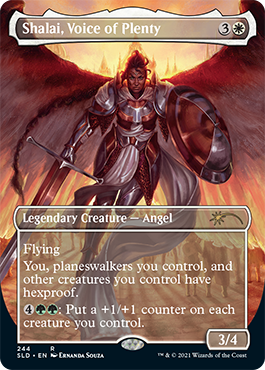
Serra Angels are the most renowned (not literally) angels in Magic's history. Their giant white and brown-tipped wings are impossible to mistake, and Shalai is one of the most recognized. Shalai is the only Serra Angel of African descent, though her art in the past has been racially ambiguous.
When concepting this card, I thought about who Shalai was at her core. She is an angelic being created to protect, to be a warrior of light, to stand up for those less fortunate. I thought about why she chose to protect the Llannowar elves in the Phyrexian invasion, her most notable achievement. Then I realized, of course she would. In human-dominated Dominaria, Llanowar elves are in some ways, a marginalized group.
Guardian angels have taken many forms in popular media, but in my home, they have always been Black. Representation is very important to us, and my mom always went out of her way to make sure my sister and I grew up with dolls, books, and shows that reflected our colorful lives. Every year for Christmas, my dad uses his superior height to put a Black angel on the top of our tree, and my mom decorates the house with a Black nativity, a diversely populated Christmas village, and Black angel figurines.
Many of the angel figurines cover children with their wings, a visual sign of their protection. In this card, I wanted to imagine who Shalai would protect in our world, and how she'd go about it. The wings of a Serra Angel are special, so I envisioned Shalai spreading her wings wide to shield the innocent, to be like so many women of color and put her heart, soul, and body on the line for her community.
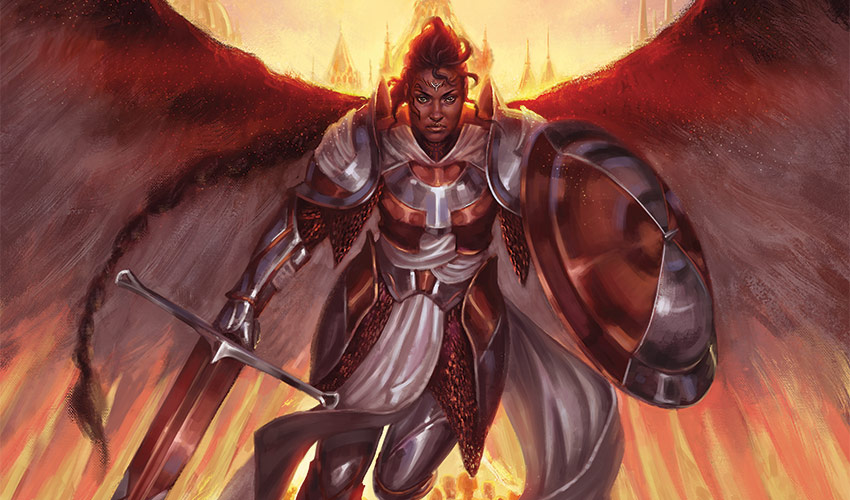
Shalai stares out, looking directly at the danger. She is unafraid, and she is powerful. If you look under her wings, you'll see the silhouette of a small child on either side holding the hand of their parent. The artist of this piece, Ernanda Souza, did a phenomenal job showing the scale of the children and their innocent body language. They also did a great job showing that the danger Shalai is shielding the people from is very real. She is looking straight toward the viewer for a reason. Whatever that danger is, don't worry, she's looking right at it and is prepared to defend you. In a lot of ways, this card is a talisman that I want to put out into the world. We might not find any real-world equivalent of hexproof, but we can try. I want the future generation to be under protection from the generational curses that plague us.
Ponder

It was quiet. It had been the first thing she'd noticed about Rielle's private quarters. Often her world was a cacophony of sound and noise. In the day she might hear the terrifying bellow of a Skyshark. At night she laid awake in fear, wondering if a nightmare from the Indatha might wander in where she slept. Like all children born to bonders, the wilderness of the outposts was not unfamiliar. She knew the perpetual conflict of their existence, the human cities that saw them with hate, and the monsters that sought to devour them. She also knew the joy that came with being truly free. Her older bonder brethren and their bonded protected her, but she was still too young to know the mystical bond of eludha. Instead, she was plagued with these fearful visions that—
"Come child."
The girl startled, realizing she had stood awkwardly at the entrance.
Rielle's kind eyes crinkled with amusement, and she smiled, gesturing for the girl to come closer. She hurried over, sitting quickly, her head bowed.
"I know this is a great honor. My mother wanted me to thank you properly for ridding me of these visions."
"Ridding you?"
She bowed lower. "I—I mean helping me."
Rielle let out a full-bodied laugh, placing her cane down by her side.
"My child, you once asked me how I became so wise," Rielle said. "Do you remember?"
"I remember."
"Good."
The older woman raised a hand, and the girl gasped, jaw dropping in surprise, when blue swirls of magic erupted from her weathered hands.
"How
"The future," Rielle chuckled.
She turned over her palm, and the swirls began to look like the moon. The girl drew closer.
"It's never certain you know. Always changing and shifting. It can never be certain. It is easy to fear the unknown."
Rielle took the girl's hand, her callouses embracing her soft brown skin. "Would you like to hold it?"
She nodded, fearful her words would break it. She held her breath, and slowly, carefully, took it in her hands.
"I did it," she whispered.
Rielle looked down at the child, her smile bright and beautiful.
"Well done. You certainly have a powerful gift. This is the first spell I learned when I was your age."
"My age?"
"Well, yes." She smirked at her mischievously. "I wasn't just born old, you know."
Rielle placed a hand on the girl's shoulder, guiding her focus back to the wavering moons.
"I know you fear your visions," she said, her eyes softening. "But you need not heed them. Think of them as possibilities. Do you understand? You are the one holding your future."
They sat in silence, letting the weight of the words wash over them, staring at the magic they could make together. The girl turned to Rielle, the fear long abandoned.
"Will the future be brighter?" asked the girl.
Rielle smiled.
"I will teach you how to make it so."
White is a color that symbolizes healing and purity, and has a direct connection to African spirituality, both traditional and modern.
The concept of religion for some Black American, African American, and African peoples is fraught with so many unspoken narratives. After the African Diaspora, those who were scattered from their original homelands lost their indigenous religions and connection to the spiritual practices of their ancestors. As an act of resistance to the pressure of Christianity, some indigenous peoples combined their beliefs with Christianity, creating new traditions like Santería and Vodun, which both have connections to Catholicism.
In modern times, there has been a rise in young Black Americans seeking out these lost traditions as a grounding way to heal and build community. I wanted this card to be a nod to this transition. It shows an elder, most notably our new Ikoria commander, Rielle, the Everwise, guiding a young seer. They are both in white clothing and headscarves, and there is a sense of power and excitement in the air. You can see African bangles on the young girl's arms, and it brings me back because I grew up with bangles in my culture. Ejiwa "Edge" Ebenebe did such a beautiful and realistic portrayal of how older Black women support younger ones, and the eagerness the younger generation has for seeking a connection with what they have lost, not to mourn, but to build a better future for themselves.
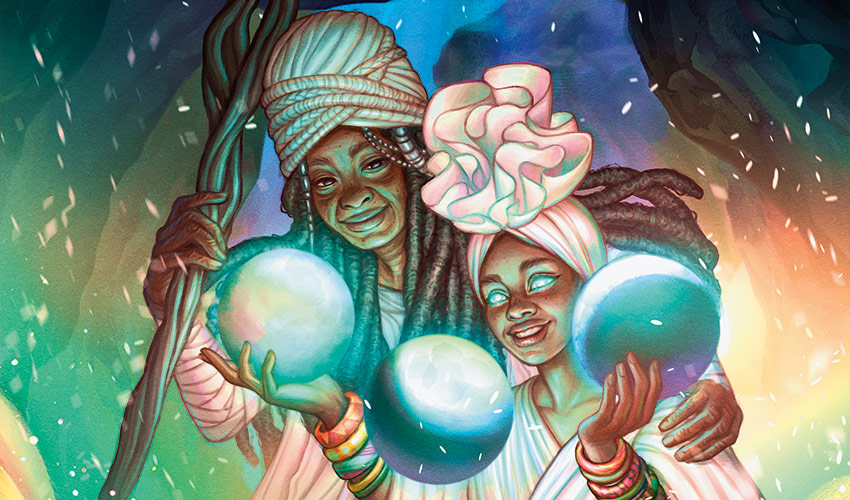
For more information, check out these articles:
- "How Some Black Americans Are Finding Solace in African Spirituality" by Nyla Burton
- "The Spirituality of Africa" by Anthony Chiorazzi
CULTIVATE
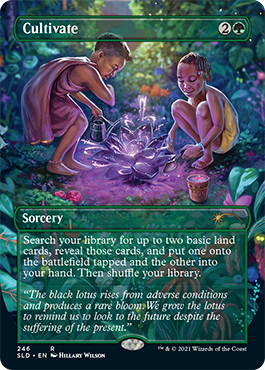
Near the beginning of the global pandemic, I started a small balcony garden. I grew cherry tomatoes from seeds in a glass jar until it grew too big and I needed a pot. I grew strawberries. I overwatered and underwatered lots of things, but I really enjoyed the time I spent learning to care for my lavender, basil, thyme, and more. I also joined a Black planters community online. Anytime I had questions, I'd take a picture and say, "Help!" and someone would have plant-saving advice. It was empowering to know I could learn how to grow things that would nourish me visually and physically. You don't see a lot of positive examples of that depicted with the Black community.
There is an expectation that due to slavery, Black people in America don't farm or grow things. Instead, there is a stigma in which we are the ones who deplete resources, offering nothing to the table but an open hand. The idea of the Welfare Queen, popularized during the 1976 election, cemented into American history the stereotypes that still impact our opinions on welfare today. In truth, these perceptions are easily debunked given a little time. When seeing the world without fear or prejudice, it is clear that this isn't true. So many Black and African people have rich food cultures and traditions with ingredients that were grown within our native communities. Growing plants for food, medicine, or shelter is just a part of reality. In countries where everyone is African, there are plenty of African farmers.
There are a lot fewer Black farm owners in this country due to the systemic oppression and prejudice they face. According to the Center for American Progress, Black farmers lost 80% of their land between 1910 and 2007. Farming is very expensive, and between denying their loans, wide-spread discrimination from the USDA, and land taken through force, local corruption, and fractured land titles, it is a herculean feat for most Black farms to stay alive.
When I concepted this card, I thought about what it means to cultivate land in this narrative. My puny "struggle-bubble" balcony garden, community plots to support neighborhoods that are food deserts, and the larger narrative of farming as a whole. This card has a lot to say, and without an article, it would be impossible to say it all. In short, it is my way of affirming the validity of Black farming and highlights ways in which growing things connects future generations to their roots.
We see two beautiful Black children growing the Black Lotus, the most iconic and powerful symbol in Magic's history. These little Black kids are not just in possession of such a powerful item, they are the ones cultivating it. They are the ones who make the Black Lotus bloom. A lotus, growing in the mud, symbolic of overcoming adversity in so many cultures. Hillary Wilson skillfully rendered this gorgeous imagery, and we can feel the magic in every corner we gaze on.
"The lotus flower blooms most beautifully from the deepest and thickest mud."
– Buddhist Proverb
In my mind, I created this brother and sister who live in a normal fantasy village, and in their backyard, they have a lush magical farm. Fantastical flowers, fruits, and vegetables grow in abundance, and the source of the land's power is this lotus that the children care for. In their culture, they grow the Black Lotus as a reminder to confront difficulty with optimism and joy. Everyone in that town gets one in their yard. Everyone has access to that joy.
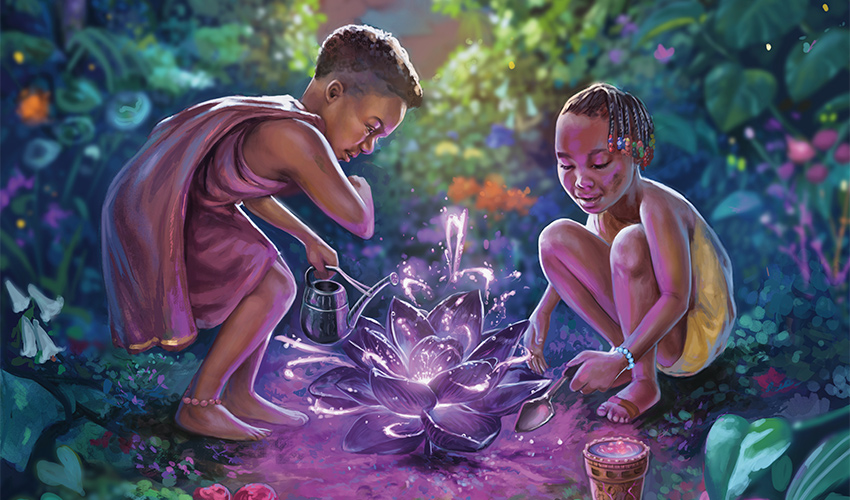
For more information, check out these links below:
- "Why Are All the Black Farmers Vanishing?" by AJ+
- "The Young Black Farmers Defying a Legacy of Discrimination" by Vice News
- "The Truth Behind the Lies of the Original 'Welfare Queen'" by Gene Demby
- National Black Farmers Association
Kaya, Ghost Assassin
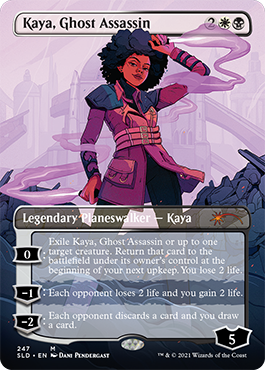
Sing me a song of power, class, and voluminous 4c curls, and I shall craft you the ballad of Kaya. I could go on and on about why I love her. Is it her effortless style and grace?
Is it her constant battle to free the oppressed from bondage and to uphold her own moral code?
Kaya is the reason I know Magic. A couple years back, I saw her leaning against a door with her sculpted cheekbones, and I was intrigued. I looked her up, found Magic: The Gathering, and the rest is history. She is proof that representation matters, and Dani Pendergast gave us this phenomenal version of her. Kaya played a pivotal role in the War of the Spark. After eliminating the corrupt ghost officials, she took over as the Orzhov leader in their place, maintaining the façade of a cruel, calculated zealot, while on the side freeing ghosts from eternal bondage and debt. Kaya would also fight alongside the Gatewatch to protect the people of Ravnica and swear an oath to watch over the Multiverse as a member. This card is what happened after Bolas was defeated. Kaya stands in the rubble just outside of the Orzhov Guild, a little battered, but incredibly triumphant. She looks powerful because she is, and her hair is of course, perfect. Kaya's afro is one of her most iconic features and a multigenerational symbol of Black power and pride. I told Dani I wanted it to remind me of Diana Ross, the diva of divas. Here's to the Black female trailblazers that change our lives and all the people supporting them. You can see Kaya in her latest adventure in Kaldheim here.
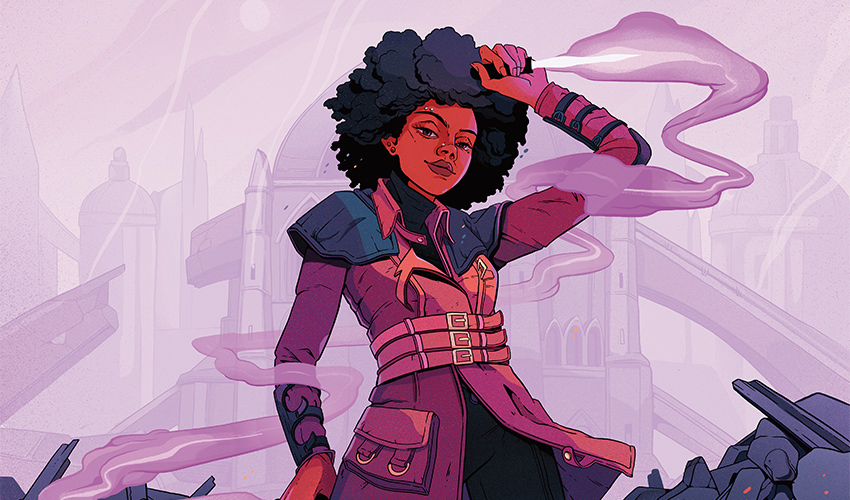
For more information:
- "How I Helped Make the First Black Woman Planeswalker in Magic: The Gathering History" by Monique Jones
Teferi, Hero of Dominaria
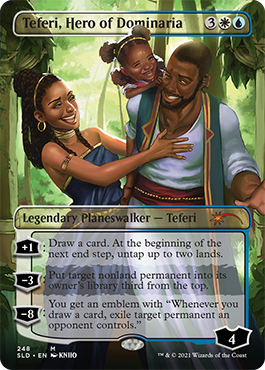
This card is my love letter to Black fatherhood and family, and I think honoring Magic's favorite Time Dad is the perfect way to do it. Teferi is the first Black Planeswalker in Magic's history and has some of the most impactful cards and richest backstories in our lore. Before he was a wise authority figure, he was a student of Urza and a notorious prankster. Players watched Teferi grow up with the franchise, from a boy
to a young man
and finally, to a father.
My favorite part of Teferi's story occurs after he has lost his spark and is wandering around Dominaria. He is broken down emotionally, a villain to most who know of him, and looks young, but has lived several lifetimes. By chance, he ends up framed in a murder plot involving a caravan of modern-day Zhalfirins. These travelers are undesirables, regarded with suspicion and offered no help, and he empathizes as an outcast himself. There, Teferi meets his future wife, Subira—the caravan leader, and a powerful figure in her own right.
Subira is smart, witty, and level-headed. There's instant chemistry between her and Teferi, and while the story and epilogue hint at it, the audience never gets to see their life together. After Teferi proves his innocence, she invites him to come along.
As the wagon rolled away, Teferi said, "You could have been killed." He trembled with exhaustion, his powers depleted.
"You're welcome," Subira said pointedly. "The least you can do is come with my caravan and keep the thieves and raiders and other threats off us. A time mage should be good at that."
– "Return to Dominaria: Episode 7"
There is so much of their story left to our imaginations. We know Subira has their daughter, Niambi, that Teferi becomes a stay-at-home dad to care for her, and Subira rejoins the caravan when Niambi is older—a bold and progressive move on both their parts. I also really appreciated that the writer, Martha Wells, made sure to note that Subira visited regularly and was an active mother. The next time we see Niambi, she is an accomplished healer, often going with her father on adventures and doing her best to keep him out of trouble. This card is what I imagine it would have been like during those years that Teferi healed from his trauma and learned to live again, bolstered by Niambi and Subira's love. So much is known about the Time Mage Teferi, but the women who made him are sometimes absent. Subira made her first visual appearance in our game in Core Set 2021, and now that we know what she looks like, I wanted to complete the family. KNIIO managed to convey the love and nurturing between them in such a small space. Every time I look at it, I think of my parents, and I can see myself and my family in his family.
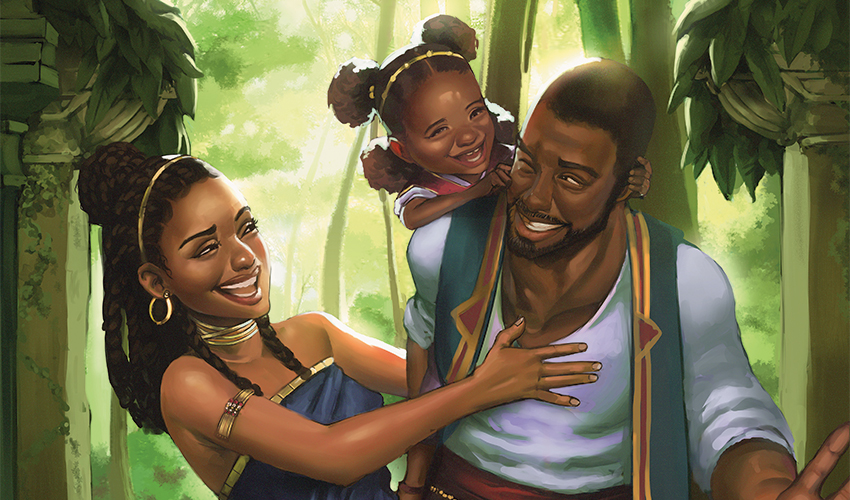
SOL RING
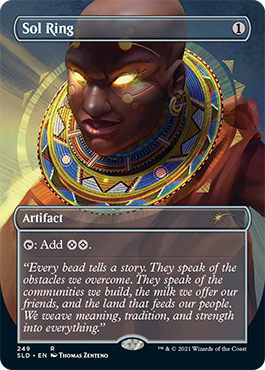
"Every bead tells a story. They speak of the obstacles we overcome. They speak of the communities we build, the milk we offer our friends, and the land that feeds our people. We weave meaning, tradition, and strength into everything."
Sol Ring is a Commander necessity. There's no better feeling then playing it on turn one, looking your friends in the eyes, and gauging their reactions. There are few cards that consistently make me feel powerful when I play them, and Sol Ring never fails to deliver. There are plenty of other things I do in life that make me feel powerful, everyday moments of joy. I feel powerful when I thread a needle on the first try. I feel powerful when I finish a 6-hour braiding session. I feel powerful when I have blue mana up and it's my friend's turn. No, I'm just smiling to smile! What? Don't worry about me, play your game. ;)
I can think of dozens of examples of that feeling, but I don't think of them when I try to visualize power. What does power look like? Is it intimidating? Empowering? Beautiful? Over the years, we've had many interpretations of Sol Ring and the power it represents. In this card, I wanted to show what another culture, specifically an African culture, might use as an object of power.
When concepting this card, I was inspired by the jewelry from the Maasai tribe. I remembered seeing one of their gorgeous necklaces in a documentary, and as I did my research, I learned more about the Maasai Wilderness Conservation trust and some of the struggles they currently face.
"Kenya recognizes over fifty tribes of native people. The Maasai were the dominating tribe at the beginning of the 20th century. They are one of the very few tribes who have retained most of their traditions, lifestyle, and lore. The Maasai have not fared well in modern Africa. Until the European settlers arrived, fierce Maasai tribes occupied the most fertile lands. The Maasai struggled to preserve their territory, but their spears were no match for armed British troops, and their lawyers never had a fair chance in British courtrooms. In 1904, the Maasai signed a first agreement, losing the best of their land to the European settlers
– Maasai Wilderness Conservation Trust
What started out as a desire to appreciate a culture with a beautiful tradition turned into the realization of the power they themselves were losing. There was now this added component to the card. The art Thomas Zenteno provided is a Magic interpretation that imbues the user with power and light. It is not only my hope to show how beautiful and meaningful Maasai jewelry is but also to bring attention to the tribe and their conservation efforts. The modern world will continue to expand, but it is our responsibility to preserve the culture and dignity of all peoples as we move forward. And to do so together.
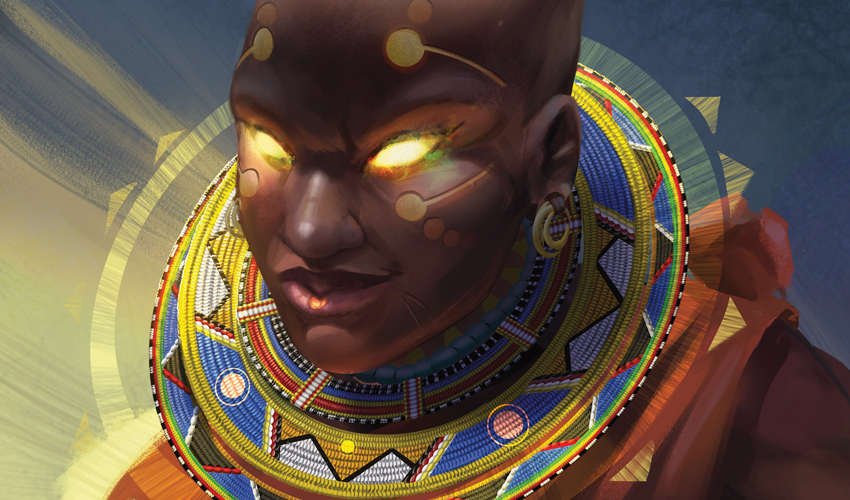
One of the reasons that Maasai jewelry is so special is that every bead has meaning. Women and men in these tribes wear these beaded pieces for many reasons, some as a symbol of their health, wealth, marital status, number of children, and more. These pieces, each unique and unlike any other, have cultural power within the tribe. The color blue symbolizes the sky, which provides water for the people and their livestock, a symbol of sustenance and energy. The color black reflects the color of the people, their daily hardships and struggles, the difficulties they must endure, and represents harmony and solidarity. The meanings behind the colors resonated with me, not because I am from that culture in any way, but because I was moved to look beyond my current understanding of the world. Everyone should know by now that Black people are not a monolith. This culture opened my eyes to a different way of thinking. Now when I wear blue, I think about how lucky I am to have clean water to sustain me. When I wear black, I think of being Black and how I have never met someone from the Maasai tribe but know exactly what they mean by daily hardships and solidarity. For a moment, I feel connected by the global experience of Blackness, and I send a silent prayer to all of us. There is a misconception that overcoming the past requires its erasure, that it is better to forget and move on. To that I say it is impossible to move on when the past is our present. Racism has never just stopped in any place that I know of. I don't know if it ever will. But what I do know is that Africans in the Diaspora lost a part of themselves. Our lineage, our heritage, our traditions, our names. It is rare to see a tribe still retaining its traditions, and I think that is one of the reasons the Maasai are so special. They are holding on to their culture and infusing every bead with meaning. Even without Sol Ring, Maasai jewelry itself is a powerful artifact.
For more information:
- "The Meaning Behind the Maasai Bead Work" by Lorraine Masemola
- Maasai Wilderness Conservation Trust
PATH OF ANCESTRY
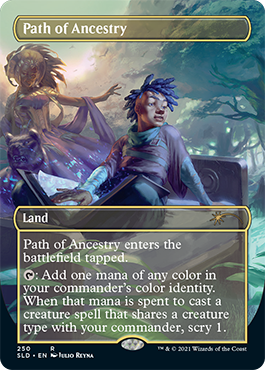
With this final card, I wanted to pay homage to one of the ancestors of Magic's Black history, Jolrael, Empress of Beasts.
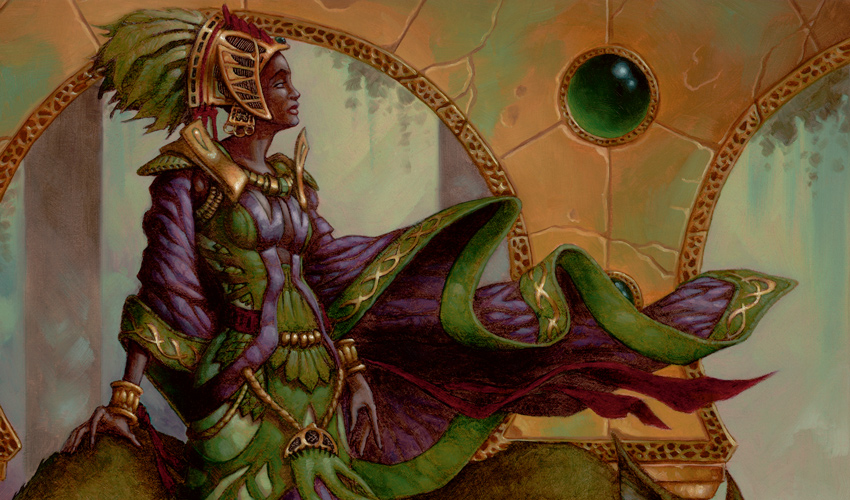
Jolrael was one of the oldest surviving Zhalfirins, a powerful and influential court mage for the capital, and a dear friend of Teferi. As a recluse in the Mwonvuli Jungle, she was the embodiment of a green-aligned character, preferring the company of animals over her bureaucratic peers. Jolrael didn't need anyone but her own magic and moral compass, but when her people needed her, she showed up. She served as a court mage at the royal houses of magic in Ki'pamu in Jamuraa, enduring the scrutiny of her colleagues who saw her as mean-spirited and unhinged. Despite this, the republic would not have survived without her, and when the Capital was stable, she returned to her solitude. Later during the Mirage Wars, she was able to see through attempts to manipulate her and ultimately made the choices that helped end the war. At home, she used her abundant magical power and connection to nature spirits to enlist the help of her animal friends, who helped her build not one but two luxurious jungle palaces. Teferi would visit her occasionally, and they remained close, their friendship built on mutual respect and admiration.
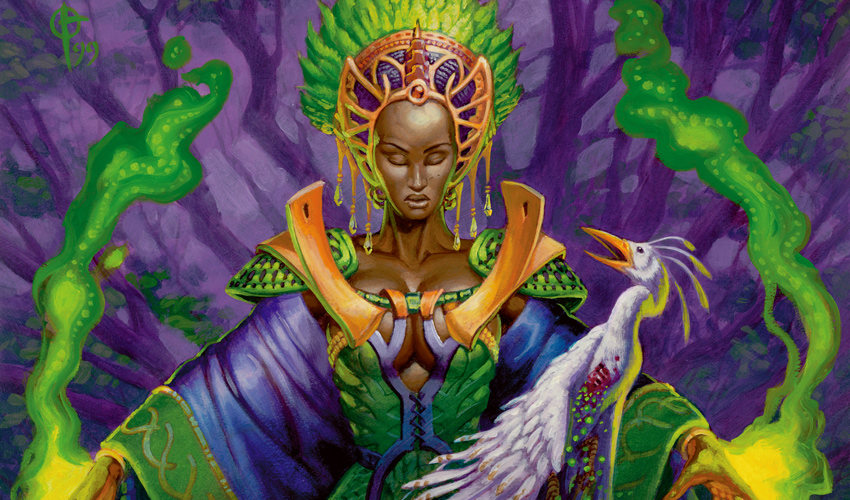
I always thought it was incredibly powerful that she never cared what anyone thought of her. She wore flowing gowns and elaborate headdresses for her own self-gratification and lived by her own terms.
If she had to quarantine, she'd be 100% unbothered. Jolrael was able to command the respect of powerful beasts and creatures long before Vivien Reid. She was the strong Black female legend before Kaya. She was a friend to Teferi before he was a Planeswalker. Jolrael is the ancestor of so many amazing characters we know and love. She paved the path.
What is a path of ancestry? I interpret Path of Ancestry to mean following the road your ancestor has broken in for you. It is honoring those who came before us, those who lived through so much and still taught us how to be resilient and bear witness to the births, deaths, and rebirths of our hopes for equality. It is every generation's dream to walk further in their name. Fantasy setting, or real life.
You, dear reader, have a path. You can trust it. You can follow it. You can do this.
Imagine a little Zhalfirin boy reading about Jolrael in his history book and being inspired to explore more of the natural world. To lead conservation efforts, to master magic and learn to speak with animals. Can you see it? The power of her example, the truth in her story transporting him from his bedroom into the jungles of Mwonvuli. And somewhere, in the space between spaces, Jolrael watches over him, and she smiles.
I like to think our ancestors look over us. Wishing us well and hoping that their contributions made a difference in our lives; connected to everything we do, and truly at peace. None of us know how we will be remembered, nor do we have much control over it. We can only hope that our efforts will be seen for what they are and taken the way we intend.
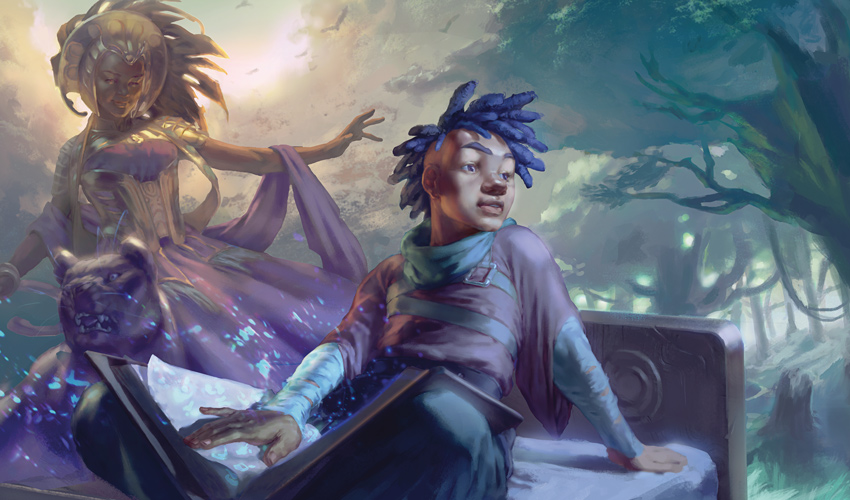
With the last card of the set revealed and the final story told, I hope my efforts will be seen for what they are. I hope my intentions are taken the way I intend. I hope you can feel my heart, and how much this product meant to me. This would not have been possible without the amazing efforts of our artists, our art director Maxx Marshall, our writer and editor Jessica Ross, our new DEI director Jontelle Leyson-Smith, the Secret Lair team, our Communications team, and so many more. From all of us to you, we hope you love this.
And from me to you, I hope my interpretation of Magic's Black history spoke to you. No matter who you are, you can celebrate Black history. You don't have to be Black to enjoy Black stories. Black stories are human stories, and human stories deserve to be told. So, we'll write them and draw them, speak them and play with them. Until everyone realizes that Black is not a stereotype, a trauma, or a threat.
Black is magic.
